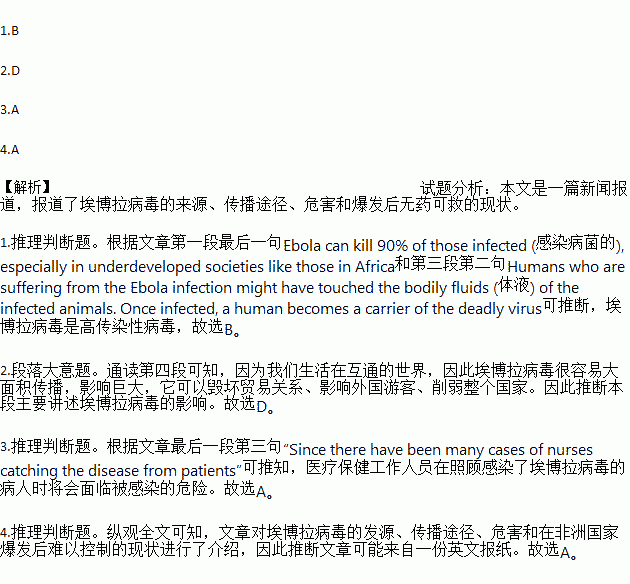题目内容
When we hear of dangerous diseases, cancer and heart disease are often what first come
to mind. Recently, a virus called Ebola has reappeared in Guinea, killing 62 people so far. It leads to high fever, bleeding and so on. Ebola can kill 90% of those infected (感染), especially in underdeveloped societies like those in Africa.
Ebola is named after the Ebola River, where it was first discovered in 1976. There are five different types of the Ebola virus, each named after where they first happened: Sudan, Ivory Coast, Reston, Bundibugyo, and Zaire. The deadliest of the five, Zaire, was responsible for the 2012 outbreak, and is believed to be attacking Guinea.
Ebola is naturally found in fruit bats, which pass on the virus to other animals by biting or sucking on their blood. Humans who are suffering from the Ebola infection might have touched the bodily fluids (体液) of the infected animals. Once infected, a human becomes a carrier of the deadly virus.
Since we live in an interconnected world, where the situation in one country can affect us all, the effects of Ebola are huge: damaging trade relations, affecting foreign visitors, and weakening entire countries. Already the Guinea virus is spreading fast with a few cases spotted in Conakry—the capital city of Guinea, far away from the origin of the virus. It is feared that the disease may have already reached neighboring Liberia and Sierra Leone, too.
Unfortunately, there are no disease-specific treatments for Ebola. Healthcare workers only supply the infected people with water to keep them in good condition. Since there have been many cases of nurses catching the disease from patients, they are forced to wear strict protective clothes, and in some cases, not even allowed to get close to the infected. The fact that there is no cure for the Ebola virus is what makes the outbreak a challenging one to control.
1.From the text we know that ________.
A. Ebola is naturally found in fruit
B. Ebola is a highly infectious virus
C. Ebola is a newly discovered disease
D. Ebola is recently controlled in Guinea
2.What is Paragraph 4 mainly about?
A. The causes of Ebola. B. The origin of Ebola.
C. The treatment for Ebola. D. The influences of Ebola.
3.In Ebola infected areas, healthcare workers _______.
A. face the danger of catching virus
B. take measures to protect the nurses
C. give water and medicine to the patients
D. do whatever they can to save the infected
4.The text probably comes from ________.
A. an English newspaper B. a tourist guide
C. a safety brochure D. a medical report


